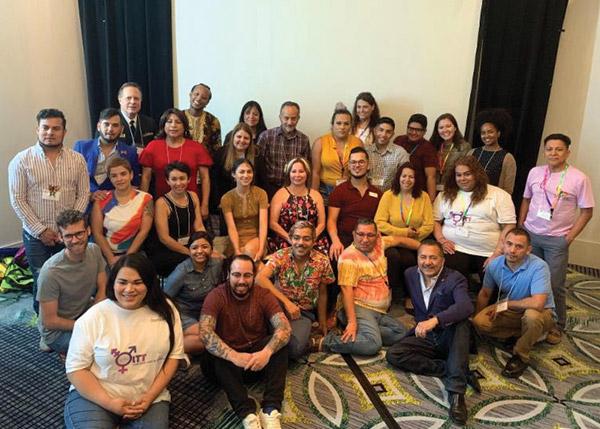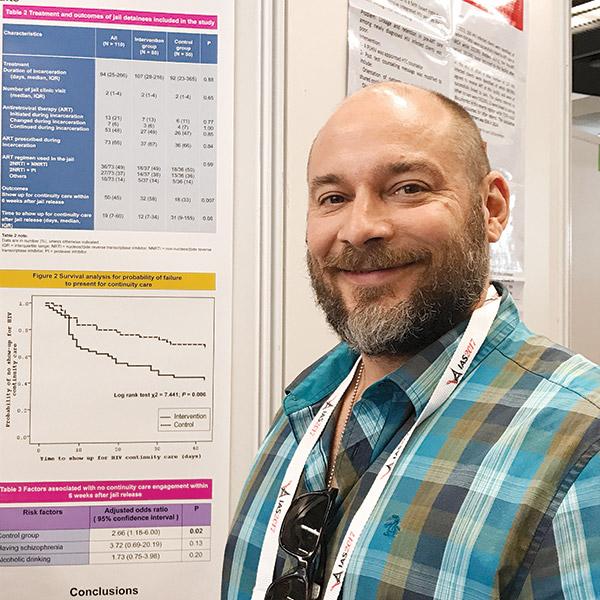
You can take antacids with Biktarvy—but carefully
The FDA in July updated interactions on the Biktarvy drug label. Do not take your Biktarvy dose at the same time with antacids, such as Tums—but it’s okay to take the popular HIV medication with Prilosec or Pepcid, among other acid suppressants.
It’s easy to see how that can be confusing.
Not all acid suppressants are antacids. Prilosec is what’s called a proton pump inhibitor, and Pepcid is an H2-receptor antagonist.
And even some antacids are okay to use with Biktarvy if you just separate them the right amount of time. In fact, some are okay to take at the same time with Biktarvy—as long as you’re taking both of them with food. See box.
In simple terms, the updated drug interactions are, well, simple: Do not take Biktarvy at the same time with medications or oral supplements that contain aluminum, calcium, iron, or magnesium. These are used in the antacid category of acid suppressants, which are commonly used. They include Tums, Rolaids, Mylanta, Maalox, Pepto-Bismol, Alka-Seltzer, and Milk of Magnesia.
Aluminum, calcium, iron, or magnesium are substances called “polyvalent cations,” and they come in different variations, such as magnesium citrate and magnesium sulfate. Look out for all the forms they come in. So, read the label. Lactaid, for example, contains magnesium stearate and Gas-X contains calcium. When in doubt, ask your pharmacist or healthcare provider.
Although not mentioned by the FDA update, zinc is also a polyvalent cation and is commonly found in nutritional supplements. Zinc should not be taken with Biktarvy unless taken with food.
There’s no need to worry about inactive ingredients, except when calcium is used as a buffering agent. Because of the potential for an interaction, separate the calcium-buffered item from the Biktarvy dose if they are not being taken together with food.
Aluminum-containing deodorants are not a problem. The absorption level is too low for any concern.
Also, only supplements taken orally are a potential problem. Don’t worry about calcium from a nutritional feeding IV, or other non-oral means of getting a medication or supplement.
As for other types of medications that control stomach acid, there is no interaction. They do not contain polyvalent cations.
Therefore, you can take Biktarvy at the same time with:
• Tagamet, Pepcid, and Zantac, among other H2-receptor antagonists (H2RAs).
• Prilosec OTC, Prevacid, Aciphex, Protonix, and Nexium, among other proton pump inhibitors (PPIs)
Special thanks to Thomas D. Chiampas, PharmD, BCPS, AAHIVP, of the University
of Illinois at Chicago College of Pharmacy for reviewing this page.
How to take these if you’re taking Biktarvy
Calcium, iron, or zinc supplements:
Biktarvy can be taken at the same time with a supplement or an antacid that contains calcium, iron, or zinc if they are taken together with food.
If Biktarvy is being taken on an empty stomach, however, then Biktarvy should be taken at least two hours before or at least six hours after the supplement or antacid.
Aluminum or magnesium:
Biktarvy can be taken at least two hours before or at least six hours after taking antacids or supplements containing aluminum or magnesium. It’s important to separate them—and food isn’t going to help overcome the undesirable drug interaction.
Also, beware of laxatives, buffered mediations, multivitamins with minerals, and the ulcer medication sucralfate (Carafate and Orafate, among others). Separate them by taking Biktarvy six hours after or two hours before the other med or supplement.
Biktarvy now for children
Biktarvy, one of the most—if not the most—prescribed HIV medications, can now be given to children. The FDA has approved Biktarvy for pediatric patients at least six years old who weigh at least 55 pounds (25 kg). No new adverse reactions or laboratory abnormalities were seen in children and adolescents compared to those seen in adults. In one clinical trial of 50 children ages 12–17, adverse reactions were seen in 10% of the study group. One child in that study discontinued participation because of insomnia and anxiety.
Biktarvy is a small tablet, and consists of three drugs in one pill.
Read the June 20 FDA announcement at bit.ly/2N0lVJk. For more information, go to positivelyaware.com/biktarvy.
Symtuza now back on ADAP
The HIV single-tablet regimen Symtuza is now back on the formularies of most of the AIDS Drug Assistance Programs (ADAPs), which are state operated. For more about Symtuza, go to positivelyaware.com/Symtuza.
New transgender section, substance use disorder information, and HIV-2 treatment added in U.S. HIV guidelines
The U.S. HIV treatment guidelines have added a new section on transgender care; updated its information on HIV-2; and re-written the section on substance use disorders (SUDs) (formerly called “HIV and People Who Use Illicit Drugs”).
The guidelines noted that 14% of transgender women and 2% of transgender men are living with HIV. This is way out of proportion to the less than half of one percent in the general population.
The new section devoted to the transgender population covers:
• Gender-affirmative care to improve HIV treatment benefits,
• Drug interactions between HIV therapy and hormonal treatment, and
• Potential health effect of gender-affirming care on transgender individuals living with HIV.
Based on new evidence from clinical trials, the guidelines now recommend that people with HIV-2 start HIV treatment with an integrase inhibitor medication. This drug class is already recommended for most people starting HIV treatment for the first time.
The expanded SUDs section now includes information on alcohol, benzodiazepines, cannabinoids, club drugs, opioids, stimulants (cocaine and methamphetamines), and tobacco.
Go to aidsinfo.nih.gov.
FDA panel recommends Descovy for PrEP—but only for men and transgender women
In a split decision, an FDA expert panel recommended that the HIV medication Descovy be approved for prevention (PrEP) for men who have sex with men and transgender women (16-2), but voted against (10-8) approving Descovy as PrEP for cisgender women (those designated female at birth) at this time.
The FDA does not have to follow recommendations from expert advisors when approving a new drug or drug indication (a new use for a current medication), although it usually follows them.
The panel made its recommendations on August 8, as POSITIVELY AWARE was going to press. Among the complex issues raised were social concerns and questions over biomedical effects.
For example, if approval of Descovy for PrEP is delayed for cisgender women, would that set back the movement to end the epidemic? There is also evidence that Descovy does not reach levels considered protective against infection in certain cells of the vaginal tract, but it’s not certain if that’s needed for PrEP.
For a number of reasons, HIV activists are asking that if Descovy for PrEP is approved for cisgender women, that studies specifically in this group be ensured and enforced. The FDA always requires continued studies and monitoring after a drug approval or new indication.
The HIV activist groups AVAC and TAG (Treatment Action Group) issued statements clarifying the panel recommendations and the many concerns, including those regarding cisgender women. Go to bit.ly/2YOtmE0 and bit.ly/33lEmMp.
Data and questions put to the panel by the FDA can be found at fda.gov/media/129607/download.
In March, Gilead Sciences, the maker of Truvada and Descovy, announced results of the DISCOVER study, which showed that Descovy was non-inferior to Truvada in preventing HIV. There were no cisgender women or transmen in the trial. Truvada was approved for PrEP in 2012, and is the only medication on the market for HIV prevention. In April, Gilead submitted a supplemental New Drug Application (sNDA) to the FDA seeking approval for Descovy as a new PrEP drug.
Gilead’s patent on Truvada is set to expire September 30 of next year.
USPSTF gives PrEP an A rating
Truvada for PrEP (HIV prevention) has received an “A” rating from the U.S. Preventive Services Task Force (USPSTF). Task force recommendations are important in ensuring that prevention services are offered and that insurance companies pay for them.
USPSTF also gave an A rating to HIV screening for all individuals aged 15 to 65 as well as all pregnant women.
An A rating means that “The USPSTF recommends the service. There is high certainty that the net benefit is substantial.” It also calls upon providers to offer or provide the service.
In an accompanying editorial on the benefits of the recommendations, Paul A. Volberding, MD, and Hyman Scott, MD, wrote, “Together, the health gains in HIV treatment, the resulting reduction in transmission, and PrEP provide the necessary tools to end the HIV epidemic. … The USPSTF Recommendation Statements should help make this happen.”
The statements were published in the June 11 JAMA and are available online at jamanetwork.com/journals/jama/fullarticle/2735509. They include a discussion of vulnerability to HIV and how it’s experienced by various groups (straight people, gay men, etc.). Read more about the financial benefits of the USPSTF recommendation at aidsmap.com/page/3488739.
One less hoop to go through to get PrEP
The FDA has ended the requirement for a Risk Evaluation and Mitigation Strategy (REMS) for Truvada for PrEP.
The REMS program provided a way for doctors and patients to learn about the new HIV prevention method back in 2012 when Truvada for PrEP was approved.
Since then, the CDC has created guidelines for PrEP use, so the educational material provided by REMS is less useful. The FDA said in its July 2 announcement that PrEP is now much more widely understood, and that important safety information can—as always—be found on the drug label.
Find the CDC PrEP guidelines at cdc.gov/hiv/risk/prep.

Leadership health summit, organized by Latinos in the South
More than 90 Latinx LGBTQ grassroots organizers, health care providers, researchers, and people living with HIV from the southeastern U.S. came together in July in Atlanta for the first ever leadership health summit, organized by Latinos in the South, a program of the Latino Commission on AIDS. Encuentro: Reconstructing Our Health (or “Encounter”) provided policy and funding workshops and networking opportunities to address issues such as health equity, HIV criminalization, immigration, and stigma.
One of the objectives of Encuentros is to raise awareness of how HIV and health disaprities affect the Latinx community in the Deep South, not just in the big cities, but in rural areas.
“The event promoted not only an important dialog, but also created a space to develop strategies to address health disparities impacting the Latinx LGBTQ community in the South, a region with the highest rates of HIV diagnosis and incidence in the nation,” said Judith Montenegro, director of Latinos in the South. For more information, go to latinodeepsouth.org.
—Rick Guasco
New book: Nurses on the Inside
Nurses on the Inside: Stories of the HIV/AIDS Epidemic in NYC presents stories from two nurses in the first years of the epidemic. Ellen Matzer and Valery Hughes dramatize the events but keep true to the realities. They say nurses all over this country went through the same experiences, and hope the book helps the world remember what those days were like.
Australian reportedly clears his HIV
An Australian man may have cleared his HIV infection, researchers say. They reported not having found any HIV DNA in him over the last 22 years. There were, however, unusual circumstances surrounding his infection. Read Gus Cairns’ report on the case at aidsmap.com/page/3511496. (No, the case won’t help anyone else any time soon.) The case was published online by J. Zaunders et. al. in the Journal of Virus Eradication, June 2019.
HIV outbreak in Pakistan hits 600 children
Pakistani officials asked the World Health Organization (WHO) in May to help with an HIV outbreak in 600 children in one province. None of the parents had HIV. However, a pediatrician was arrested that month on charges of reusing contaiminated syringes. Before the outbreak, there were around 1,000 children with HIV in the entire country. WHO reported that its work in response to the crisis included containing the outbreak, testing for HIV, counseling families, and providing HIV treatment. Read the WHO follow-up report at who.int/csr/don/03-july-2019-hiv-cases-pakistan/en.
Michael Johnson freed from prison
After serving nearly five years in prison, Michael Johnson, the young black college student and wrestler sentenced to 30 years under Missouri’s HIV criminalization law, was freed on parole in July.
“We don’t charge people with other incurable diseases, like hepatitis [A and B], with a criminal offense for exposing others,” Eric M. Selig, the lawyer who negotiated Johnson’s plea deal and release, told The New York Times.
A point made at the time of the trial by Catherine Hanssens, executive director and founder of the Center for HIV Law and Policy, reported in POSITIVELY AWARE: “The fact is that while most states also have laws that mandate disclosure or prohibit sexual contact when one has any STI, most of those laws are 1) minor misdemeanors and 2) rarely if ever enforced. Another fact is that people infected with other forms of STIs who decide to pursue legal recourse almost always file civil tort claims against their partners, not criminal charges.”
She called the case against Johnson “Webster-defined hysteria, the perfect storm of deeply ingrained homophobia, racism with all of the associated stereotypes, and steadfast ignorance about HIV transmission routes, risks, and current-day realities.”
“With joy in our hearts, today, the Counter Narrative Project, our tribe, and our partners would like to welcome Michael Johnson home!” wrote executive director Charles Stephens. “So much of the heart and soul of CNP is in our work done in partnership to free Michael from prison.”
Johnson is staying with supporters during his probation.
Journalist Steven W. Thrasher, PhD, who is the Daniel H. Renberg chair at Northwestern University Medill School of Journalism, has followed Johnson’s case from the beginning for BuzzFeed News, and has written a dissertation on the intersection of HIV criminalization and racism. He told The Times he was drawn to the case for its similarity to lynching. Follow @thrasherxy.
The Sero Project focuses specifically on fighting HIV criminalization laws. Go to seroproject.com.
Awareness campaign helps ‘spread the tingle’ of PrEP
A study reviewing Chicago’s PrEP4Love (P4L) social media campaign found it had 41 million unique views and nearly 25,000 users clicking on its content.
“The PrEP4Love campaign has proven the value of centering pleasure and intimacy over traditional fear-based tactics that are commonly found in HIV/STI prevention,” said Elijah McKinnon, creative director and founder of People Who Care and PrEP4Love model ambassador, in a press release from the AIDS Foundation of Chicago (AFC).
The campaign featured intimate and sexually evocative photos of people from Chicago communities that are especially vulnerable to HIV, with messages such as “spread tingle.”
AFC led the Illinois PrEP Working Group (formerly the Chicago PrEP Working Group) that created P4L.
HIV specialist and working group member John Schneider, MD, MPH, from the University of Chicago, said, “this paper is the first to describe a sex-positive PrEP public health campaign that is affirming to young, same gender-loving men, transgender women and cisgender women, and is inclusive of their sexual orientation. Overall, the campaign reached millions of individuals, with substantial numbers receiving continuous education through multiple modalities including online, phone, and print.”
According to the release, “the data from the ad views, website, and PrEPLine outcomes demonstrated that grassroots campaigns, such as PrEP4Love, can be implemented successfully and reach millions of people to increase awareness for other areas in public health within a short amount of time.” The majority of the website’s clicks were to the page to locate a PrEP provider.
The study was published June 17 in the JMIR Public Health and Surveillance journal. Read it at publichealth.jmir.org/2019/2/e12822.
A new online resource on HIV and aging
GMHC has launched a new National Resource Center on HIV and Aging (NRCHA), the first of its kind. NRCHA will serve as a hub for disseminating research-based information on HIV and aging to improve the quality of life of older adults living with or vulnerable to HIV through its website, agingHIV.org.
“This National Resource Center for HIV and Aging site addresses an unmet need,” says leading HIV and aging researcher Stephen Karpiak in an editorial, who is also the NRCHA Director. “The older adult with HIV needs information that will empower them to take better control of their health and advocate for the best care as they age.”
The Resource Center will have basic information needed on the clinical and psychosocial challenges older adults with HIV confront as they age.
“Health seeking behaviors must change,” says Karpiak. “The clinical information on this site reflects the treatment recommendations developed and monitored by the American Academy of HIV Medicine. Years of research document the extreme social isolation and associated high rates of unmanaged depression that these older adults with HIV confront. The site details the risks for multimorbidity that can be changed to improve health outcomes.”
There is a community map that graphically shows what programs aimed at the older adult with HIV are being provided by ASOs, CBOs, and other organizations across the U.S., and additional resources will include slide decks, summaries of research data, sponsored webinars, details of trainings/interventions being developed, publications, and graphics for downloading.
“As we move toward the end of the third decade of the HIV epidemic, this Resource Center recognizes the need to give priority to the needs of older adults living with HIV.”

In the clinic
“It’s not just newly diagnosed people who need information. I’ve had long-time patients say, ‘I know there are two important numbers, but I can’t remember which one is supposed to go up [CD4 count] and which one’s supposed to go down [viral load].’”
—John J. Parisot, PhD, MSN, RN,
Michael Reese Research & Education Foundation, Chicago
See John’s article, “HIV: The Basics”
Share your clinical and medical insights with POSITIVELY AWARE for our In the Clinic feature. Send to e.vazquez@tpan.com .


